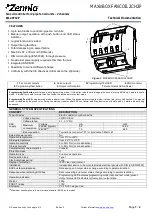
64
ION/CME N-Series Digital Drive Developer Kit User Manual
3
available interfaces beginning at 5 mils (.127 mm) or even less. For use with N-Series IONs thermal transfer materials
that are thicker than 40 mils (1.0 mm) are not recommended regardless of the material used.
When using thermal paste or thermal epoxy glue the thickness should be carefully controlled via a silk screen or other
wet film application process. The N-Series unit itself should not be used to squeeze non-uniformly applied paste or
epoxy flat during installation. Doing so may result in damage to the unit.
Whether using tape, pads, paste, or epoxy, as shown in
, the thermal transfer material that is used as the
interface should not extend to the area under the N-Series ION’s tabs because this may reduce the amount of
compression that occurs in the thermal transfer area. The following table provides dimensions for the applied thermal
transfer material for N-Series IONs:
3.7.3
Additional Mounting Information
There are a number of additional precautions and procedures that should be followed to maintain the electrical and
mechanical integrity of the N-Series ION unit during installation.
Soldering N-Series ION units in place
. Applications that involve N-Series ION units mated to a supporting plate should
take special care to insure that the solder joints are not stressed by the supporting plate once installed. The
recommended method to achieve this is to mechanically mate the unit to the supporting plate before soldering into
the PCB. If, for whatever reason, this is not possible, then special care should be taken to insure that the N-Series ION
is aligned with the supporting plate after soldering and before mechanical attachment so that upon mechanical
attachment no stress is placed on the ION unit, the solder contacts, or the PCB.
Mounting surface flat and clean
. Thermal performance as well as safe operation of the N-Series ION requires that the heat
sink or supporting plate surface that it is mounted to be flat and clean, free of dust, grease, or foreign objects. The
recommended maximum deviation of the mating surface flatness is 3 mils (.076 mm).
Progressive tightening
. N-Series ION units that are mated to a heat sink or supporting plate should be attached by
progressively tightening each of the unit’s four tabs. This means that one screw may be tightened, followed by the
others, than back to the first etc. until the desired torque at each screw has been achieved. Following this procedure is
particularly important when installing N-Series ION units over paste or epoxy, where the subsurface layer will undergo
compression and movement before settling to a final installed position.
Parameter
Maximum Pad Dimensions
Value
33.5 mm x 33.5 mm (1.32" x 1.32”)
It is the responsibility of the user to ensure that all N-Series ION units have been installed within the prescribed
mechanical stress limits and following the above described procedures. Failure to observe any of the above rec-
ommended procedures and limits may result in incorrect operation or failure of the unit during operation.
Summary of Contents for CME N Series
Page 6: ...vi ION CME N Series Digital Drive Developer Kit User Manual ...
Page 8: ...viii ION CME N Series Digital Drive Developer Kit User Manual ...
Page 30: ...30 ION CME N Series Digital Drive Developer Kit User Manual 1 ...
Page 58: ...58 ION CME N Series Digital Drive Developer Kit User Manual 3 7 6 7 6 PP LQFK ...
Page 69: ...ION CME N Series Digital Drive Developer Kit User Manual 69 4 ...
Page 70: ...70 ION CME N Series Digital Drive Developer Kit User Manual 4 ...






































